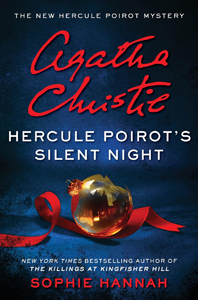“Hercule Poirot’s Christmas” (1938) is a solid book with one of the most unlikely types of killers in Agatha Christie’s catalog, but it’s a little short on holiday spirit. The 1960 short story “The Adventure of the Christmas Pudding” (a.k.a. “The Theft of the Royal Ruby”) makes up for it, as Poirot experiences an old-fashioned English Christmas and solves a mystery as a side note. But generally, the author known for producing “a Christie for Christmas” wasn’t big on Yuletide trappings.
“Hercule Poirot’s Silent Night,” Sophie Hannah’s fifth Poirot novel, fills the gap but comes at Christmas spirit from a reverse angle. Poirot’s and Catchpool’s stay in a crumbling seaside mansion near Norfolk emphasizes cold rooms, empty hearths and bland meals.
They both champ at the bit to get the hell out of there so they can have Christmas at Whitehaven Mansions. It’s like the chilliest parts of Dickens’ “Christmas Carol,” but things warm up as Catchpool decorates the trees in various rooms; at least the Laurier family has decorations available.

“Hercule Poirot’s Silent Night” (2023)
Author: Sophie Hannah
Series: New Hercule Poirot Mysteries No. 5
Genre: Mystery
Setting: Norfolk, England, Christmas 1931
As we know from her first four entries, Hannah is fascinated by how Poirot solves crimes by understanding the psychology of the killer. But in “Silent Night,” she crosses a line wherein the killer’s actions are so psychologically imbalanced that it’s not plausible that even Poirot could figure it out.
From psychology to psychotic
I can’t go into detail without spoiling things, but suffice it to say that the killer’s reason for killing the first victim is insane. I use that word literally. While Hannah provides clues that the killer is not totally stable (that’s true of the entire Laurier household, so the clues aren’t all that pointed), the reason for the murder is illogical even for a psychotic person.
The fact that the killer gets away with it (temporarily) is a lucky break, not the result of a decision based on logic in any form, but Hannah presents the actions as if there’s some logic in play.
“Silent Night” is slower-moving than the previous Hannah books. Sometimes this is welcome; it’s good that people slow down a bit at the holidays. Catchpool decorates the mansion’s four (!) Christmas trees and picks up information (as Poirot knows he will) from seemingly casual chats with the residents and guests.
But overall, the author is treading water. We start with the investigation of the first killing: A patient at the Norfolk hospital is murdered in the room next to what will be Arnold Laurier’s room; Arnold intends to move in after the holidays and die there in the following year, 1932. (This morbid emphasis on mortality infuses the book, so this is the Scroogey brand of Christmas spirit.)
Arnold’s wife, Vivienne, wants Poirot to solve the hospital murder before Arnold moves in; she inexplicably fears he will be the next victim. This setup isn’t too bad (before it becomes apparent that Hannah has overreached). On top of this we get a teaser about how Catchpool, writing in retrospect as he always does, believes that while Poirot solved the crime on a factual level, he is wrong about the killer’s motive.

A chilly brand of Christmas spirit
Hannah gives broad portrayals of feuding sisters and brothers (a pair of sisters is married to a pair of brothers, leading to power games), and parents whose only Christmas wish is for everyone to get along. And we meet Catchpool’s mom, Cynthia, who we knew from previous books he doesn’t get along with. In “Silent Night,” we understand why. Although Cynthia is a guest, she can very much be counted among the off-kilter residents of the teetering abode.
Most of the characters are too broad to ring true, like they were developed for a plot-driven short story and Hannah wasn’t inspired to expand upon them for a character-driven novel. She settles for absurdism, such as an idiot local detective and the least observant half-dozen witnesses to ever be within shouting distance of a murder.
The characterizations of the first victim and Arnold are that they are “happy,” so it’s odd that anyone would want them dead. I would’ve liked for Arnold’s happy nature to manifest as Santa-like jolliness, for the sake of more flavor.
The author has gone too far this time into a fictional world where anyone is capable of killing anyone else. In this pseudo-reality, someone being “happy” is the ultimate veil of protection from murderers, and – bizarrely — the puncturing of this veil is what draws Poirot’s obsession. But happy people are (in the circles detectives move in) murdered fairly regularly.
Flawed but not without flavor
Poirot is surprised by the wrong thing in this story, and ultimately, he solves this case because we’re told he solves it. The deductions are not as crisp as Hannah wishes they were.
“Silent Night” is easy to rip into, but I don’t want to be a total Grinch. Hannah gives me reasons to keep turning pages. The prose flows smoothly, and Poirot and Catchpool continue to make a great team. As always, Poirot gathers everyone together for the revelation in grand fashion, with characters begging him to cut to the chase just as the reader is silently doing.
It’s all in winky fun, and the overall readability (along with that smidgen of warm cheer provided by Catchpool’s decorations) is why I give “Hercule Poirot’s Silent Night” a mild recommendation. But I can’t recall a Christie book where the killer’s actions are as implausible and psychologically unbelievable as they are here.

